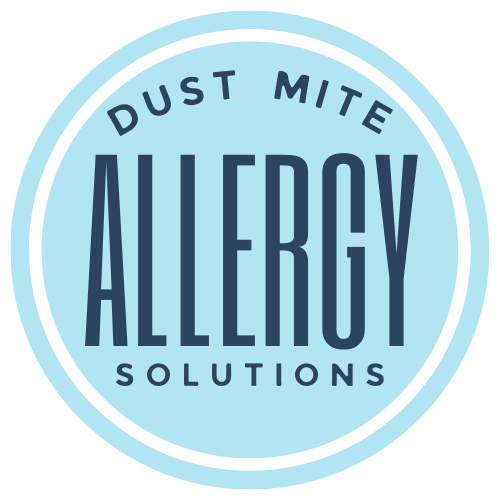How to eliminate dust mites
If you're reading this, you're likely looking for ways to eliminate dust mites, possibly because you or someone close to you wakes up sneezing or rubbing itchy eyes without realising that these symptoms are often caused by tiny creatures called dust mites.
Perhaps you or a loved one has recently discovered an allergy to dust mites. Drawing from my experience with my youngest child, I understand that seeking dust mite allergy solutions can feel overwhelming, especially when dealing with something invisible that seems to be everywhere.
In this guide, I will focus on ways to eliminate dust mites, examining both conventional and natural methods, and evaluating which products are most effective in eliminating dust mites – permanently!
Why Do I Have Dust Mite Allergy
According to Mayo Clinic, your risk of developing a dust mite allergy is heightened if you have a family history of allergies, are exposed to high levels of dust mites, especially early in life, or are a child or young adult.
Cleveland Clinic states that if you have asthma, eczema, hay fever (allergic rhinitis), or a family history of atopy, your chances of developing a dust mite allergy increase. Atopy means you're more likely to get allergies because it runs in your family.
Symptoms of Dust Mite Allergy
According to Mayo Clinic, dust mite allergies can trigger a range of symptoms, which can vary in severity from person to person. These symptoms are often similar to those of other allergic reactions, particularly those caused by airborne allergens.
Common symptoms of a dust mite allergy are sneezing, runny or stuffy nose, cough, red, itchy, or watery eyes, itchy skin or eczema, rashes or skin irritations, difficulty falling asleep or staying asleep due to nasal congestion or respiratory distress and general allergic symptoms such as fatigue and irritability.
It is important to see your doctor to get an allergy test and diagnosis if you suspect you have dust mite allergy.
Dust Mite Allergy Treatments
Treatment options for dust mite allergies primarily focus on:
- reducing symptoms (allergy medications, decongestants, immunotherapy)
- limiting exposure to dust mites (removing allergens from your environment)
According to Mayo Clinic, typically treatment involves a combination of allergy medications, such as antihistamines, decongestants, or nasal corticosteroids, to relieve symptoms like sneezing, runny nose, and nasal congestion.
For more severe cases, allergen immunotherapy (allergy shots) might be recommended, which gradually desensitizes the immune system to dust mites.
Consulting with an allergist is important to develop a personalised treatment plan based on the severity and nature of the allergy.
Effectively eliminating the irritant is a key strategy. This article delves into various approaches to reduce dust mite allergens in your home.
Dust Mite Allergies in Kids - Our Story
There's nothing quite like a mom on a mission, especially when it comes to her kid's health. My little one struggled with nasty ear infections as a baby, slept with her mouth open as a toddler (due to congestion) and was waking up a lot in the night, and it seemed like she caught a cold every week as a young child. I was at my wit's end, feeling totally overwhelmed. But then, our family doctor suggested she might have an allergy, and sure enough, tests confirmed it was a dust mite allergy.
Looking back, I realised that a lot of the symptoms she had all along were due to quite a severe dust mite allergy. Finally, we had some answers. You can read about our journey to finding dust mite allergy solutions in the about us page.
What Are Dust Mites
Dust mites are microscopic bugs commonly found in homes, particularly in dusty and humid areas. Although they're a frequent cause of allergies and respiratory issues in sensitive people, dust mites are generally harmless and don't bite, unlike bed bugs. Dust mites, invisible to the naked eye, feed on dead skin cells in household dust. They don't originate from outside but are a natural part of indoor environments. Our beds, sofas, carpets, mattresses, curtains - are all perfect places for dust to hide and for dust mites to thrive in.
What Do Dust Mites Look Like
Under a microscope, they appear as tiny, eight-legged creatures, somewhat similar to spiders, as they belong to the arachnid family. Typically, they measure about 0.2 to 0.3 millimeters in length. In terms of appearance, dust mites have oval-shaped, creamy-white bodies. Their small size and translucent bodies render them virtually invisible in a typical home environment. While you cannot see dust mites themselves, their fecal matter and the effects of their presence, such as increased allergy symptoms, might be noticeable in areas where they are abundant, like bedding and upholstered furniture.

Where Do Dust Mites Live
Dust mites predominantly reside in household environments, thriving in places that offer warmth, humidity, and their primary food source: dead skin cells shed by humans and animals. They particularly favor areas in homes that provide these conditions, making them suitable habitats.
Here are some of their most common habitats:
Bedding: Mattresses, pillows, and blankets offer a perfect environment for dust mites due to the warmth and moisture provided by the human body, along with the ample supply of skin cells.
Upholstered Furniture: Sofas, armchairs, and other upholstered pieces of furniture are ideal for dust mites, especially in crevices and beneath cushions where skin cells accumulate.
Carpets and Rugs: The fibers in carpets and rugs trap skin cells, hair, and other organic matter, providing a feast for dust mites.
Curtains and Drapes: These can also harbour dust mites, particularly if they are not cleaned regularly.
Soft Toys: Stuffed animals and soft toys, especially those that are frequently used and seldom washed, can become homes for dust mites.
Clothing and Closet AreasWardrobes or closets, where clothes are stored, can also be a haven for dust mites, particularly in items that are not frequently used or washed.
Unusual Places You Might Find Dust Mites: Consider your bookshelves that can be a haven for dust mites, as they feast on the microscopic organic matter that books accumulate over time. Similarly, decorative throw pillows and seasonal clothing stored in closets or attics provide an ideal environment for dust mites, especially if these items aren't regularly cleaned or aired out. Another surprising hideout is your car's interior, particularly in the upholstery and carpets, where they thrive unnoticed. Even electronic devices like computers and TVs, which gather dust over time, can harbour mites. Lastly, consider your bathroom rugs and mats; while they might not seem like typical spots, the combination of human skin cells and humidity makes them a potential hotspot for dust mite activity.

How to Eliminate Dust Mites in Your Home
Use Dust Mite Mattress Protectors, Pillow Covers and Doona Covers: Encase mattresses and pillows in covers specifically designed to prevent dust mites from penetrating.
Wash Bedding Regularly: Launder sheets, pillowcases, and blankets weekly in hot water, ideally at a temperature of at least 54°C.
Maintain Low Humidity: Aim to keep indoor humidity levels below 50% to create an inhospitable environment for dust mites. You can use an air quality monitor or a hygrometer to keep an eye on humidity levels in your home.
Vacuum Regularly with a HEPA Filter: Use dust mite vacuum equipped with HEPA filters, water filtration or UV-Light to effectively capture dust mites and their waste products from carpets and upholstery.
Steam Clean Carpets and Upholstery: Periodically steam clean carpets, rugs, and furniture to kill dust mites with high heat.
Dust with Microfiber or Damp Cloth: Regularly clean surfaces with a microfiber or damp cloth to avoid dispersing mite allergens into the air.
Wash Curtains and Blinds: Clean curtains, drapes, and blinds regularly to remove dust mite habitats.
De-clutter Your Home: Reduce clutter where dust can accumulate, making spaces less attractive to dust mites.
Air Purifiers with HEPA Filters: Use air purifiers for dust mite allergies equipped with HEPA filters to help remove dust mite allergens from the air. Discover more about the effectiveness of air purifiers in combating dust mite allergies.
Replace Carpets with Hard Flooring: If possible, replace carpets with hardwood, tile, or linoleum flooring to reduce dust mite habitats.
Use Hypoallergenic Bedding: Opt for bedding made from materials less hospitable to dust mites. Find out what bedding is best for dust mite allergies in our guide. Consider also your pillows and quilt if you notice allergic reactions stronger in the mornings.
Did you know there is a difference between hypoallergenic bedding and anti-allergy bedding? Consider bedsheets that are made from materials that will be most allergy-friendly and will handle washing in high temperatures.
Finally, if your mattress is a few years old, it might be a resort for dust mites. Read our guide on what are the best options for a mattress if you have a dust mite allergy.
Regularly Wash Soft Toys: Launder or freeze soft toys to kill any dust mites that may be present.
Control Indoor Temperature: Keep the house at a lower temperature, as dust mites thrive in warm environments.Use Dust Mite Spray: Wondering which dust mite spray is the best among the various options available in the market? You can opt for a natural approach or a chemically based approach when it comes to spraying dust mites.
Sun Exposure for Bedding and Rugs: Periodically air out bedding, rugs, and other furnishings in the sun, as UV light can help to kill dust mites.
Avoid Heavy Drapes and Upholstered Furniture: Choose furnishings that are less likely to harbor dust mites, such as leather sofas and blinds instead of heavy curtains and fabric sofas. Read our guide to find out how to get rid of dust mites in your sofa.
Keep Pets Out of Bedrooms: Limit pets from entering bedrooms to reduce the amount of dander, which dust mites feed on. Pets can also have dust mite allergy, find out what to do if you suspect your dog might have dust mite allergy.
Regular Cleaning: Your bed, especially if it has fabric headboard, might be harbouring dust mites. Make sure you clean behind the headboard and under the bed. Clean your mattress regularly to get rid of dust mites and consider professional cleaning services for deep cleaning of carpets, upholstery, and mattresses.
Click here for a comprehensive, room-by-room guide to get rid of dust mites.
Natural Ways to Eliminate Dust Mites
There are natural methods that can be used to get rid of dust mites.- Laundering items at 60°C and drying them thoroughly eliminates dust mites, while freezing non-washable items like plush toys for 48 hours can also be effective.
- Steam cleaning, reaching temperatures of 121°C, is great for treating couches, beds, and carpets.
- Exposing items to direct sunlight can reduce mite populations.
- Essential oils such as eucalyptus, tea tree, lavender, and peppermint, used in diluted sprays, can kill dust mites.
- Diatomaceous earth, sprinkled and vacuumed up later, dehydrates dust mites, as does using baking soda before vacuuming.
- Vinegar solutions can remove allergens, although they don't kill mites directly.
- Keeping indoor humidity below 50% with dehumidifiers creates an environment unsuitable for mites.
- Air purifiers with HEPA filters help reduce airborne dust mite particles.
- Replacing carpets with hard flooring reduces mite habitats.
- Regular cleaning with a HEPA filter vacuum and using hypoallergenic or anti-allergy covers on bedding can also significantly reduce dust mite presence.
Read our complete list of natural ways and methods to eliminate dust mites.
Best Products to Eliminate Dust Mites to Reduce Allergens
Bedding and Upholstery
- Dust Mite Mattress Protectors: Fully encase mattresses to prevent dust mites from colonising.
- Dust Mite Pillow Protectors: Similar to mattress covers, but for pillows.
- Dust Mite Duvet Covers: Your duvet could be full of dust mites.
- Hypoallergenic Bedding: Pillows and duvets, designed to resist dust mites.
- Allergy-Friendly Bed Sheets: Make sure that your bed sheets can withstand hot temperature needed to wash to get rid of allergens.
- Washable Stuffed Animals: Ensure that any plush toys are washable to regularly eliminate dust mites. Allergen reducing laundry additive is available to help eliminate dust mites.
Cleaning Equipment
- HEPA Filter Dust Mite Vacuum Cleaners: Efficient at capturing small particles, including dust mite waste.
- Steam Cleaners: Ideal for deep cleaning carpets, curtains, and upholstery where dust mites reside.
- Microfiber Dusting Cloths: Effective for trapping dust without scattering it into the air.
Cleaning Agents
- Dust Mite Laundry Detergent: Formulated to kill dust mites at lower temperatures.
- Diatomaceous Earth: Natural, fine powder that dehydrates and kills dust mites.
- Essential Oils (e.g., Eucalyptus, Tea Tree, Lavender): Can be used in diluted form for surface cleaning.
- Dust Mite Sprays: Neutralise allergens on surfaces.
Air Quality
- Air Purifiers with HEPA Filters for Dust Mite Allergies: Capture airborne dust mite particles.
- Dehumidifiers: Keep indoor humidity below 50% to create an inhospitable environment for dust mites.
- Hygrometers and Air Quality Monitors: Monitor humidity levels in your home.
Find out what are the top 10 most popular products to get rid of dust mites.
Home Modifications
- Hard Flooring: Replace carpets with hardwood, tile, or linoleum flooring to reduce dust mite habitats.
- Minimalist Decor: Reduce clutter where dust can accumulate.
- Blinds or Washable Curtains: Easier to keep dust-free compared to heavy drapes.
Read our guide on how to kill dust mites.
Dust Mite Prevention Tips
Regular Cleaning: Establish a cleaning routine. Consistency is key.Reduce Clutter: Less stuff means fewer places for dust mites to hide.
Control Humidity: Aim to keep your home's humidity below 50%.
Keep a Cool Environment: Dust mites thrive in warm temperatures, so keep your home cool.
Ventilate Your Home: Regularly open windows and use exhaust fans to reduce humidity.
Avoid Wool and Feather Bedding: Opt for hypoallergenic materials that are less attractive to dust mites.
Minimise Clutter: The less clutter, the fewer places for dust mites to hide.
Declutter Fabric Items: Keep fabric-based decorations to a minimum.
Remove Carpets if Possible: Hard floors are better than carpets for controlling dust mites.
Regularly Clean Rugs: If you have rugs, clean them frequently.
Choose Leather or Vinyl Furniture: These materials are less hospitable to dust mites compared to fabric upholstery.
Regular Pet Grooming: Groom pets regularly to reduce the amount of dander and hair in the home.
Keep Pets Off Beds: If possible, prevent pets from sleeping on beds to minimise dander.
Invest in Mite-Resistant Materials: For items like curtains and carpets, choose materials less likely to harbour dust mites.
Occasional Deep Cleaning: Consider professional cleaning services for deep cleaning tasks that are difficult to do regularly.
Specific Strategies for Key Areas to Eliminate Dust Mites
-

Get Rid of Dust Mites - Your Room by Room Guide
Dust mites - get rid of themOur best tips and advice to get rid of dust mites in every room in your home.
-

How to Get rid of Dust Mites in Mattress: A Step-By-Step Guide
Get rid of dust mites in your mattressFollow this detailed guide to eliminate dust mites from your mattress.
-

How to Get Rid of Dust Mites in Your Sofa
Banish dust mites from your sofaDo you sneeze every time you sit in your sofa? Follow our best tips to eliminate dust mites from your sofa.
-

Controlling Humidity: The Key in Dust Mite Reduction
Key in dust mite reductionFind out how humidity can impact the growth of dust mites in a home.
-

How Can I Kill Dust Mites?
Become a dust mite ninjaLearn about the differences between killing and eliminating dust mites.





